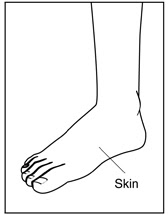High levels of glucose from diabetes causes two problems that can hurt your feet:
One problem is damage to nerves in the legs and feet. The nerves are damaged, can not feel pain, heat or cold in the legs and feet. A sore or wound in the foot may get worse because they know it's there. The lack of sensation is caused by nerve damage, also known as diabetic neuropathy. Nerve damage can lead to an ulcer or infection.
The second problem happens when not enough blood to the legs and feet. Poor blood flow makes it difficult for an ulcer or infection to heal. This problem is called peripheral vascular disease, also called peripheral vascular disease. Smoking when you have diabetes makes blood flow problems much worse.
For example, you get a blister from shoes that do not fit. You do not feel the pain of the blister due to damage to nerves in the foot. Next, the blister gets infected. If blood glucose is high, the extra glucose feeds the germs. Germs grow and the infection gets worse. Poor blood circulation in the legs and feet can slow healing. From time to time never heals a severe infection. The infection can cause gangrene. If a person has gangrene, the skin and tissue around painful death. The area becomes black and smelly.
To prevent the spread of gangrene, the doctor may have to do surgery to cut off a toe, foot, or part of a leg. The cutting of a body part is called an amputation.
Nerve damage:
One problem is damage to nerves in the legs and feet. The nerves are damaged, can not feel pain, heat or cold in the legs and feet. A sore or wound in the foot may get worse because they know it's there. The lack of sensation is caused by nerve damage, also known as diabetic neuropathy. Nerve damage can lead to an ulcer or infection.
Poor blood flow
The second problem happens when not enough blood to the legs and feet. Poor blood flow makes it difficult for an ulcer or infection to heal. This problem is called peripheral vascular disease, also called peripheral vascular disease. Smoking when you have diabetes makes blood flow problems much worse.
For example, you get a blister from shoes that do not fit. You do not feel the pain of the blister due to damage to nerves in the foot. Next, the blister gets infected. If blood glucose is high, the extra glucose feeds the germs. Germs grow and the infection gets worse. Poor blood circulation in the legs and feet can slow healing. From time to time never heals a severe infection. The infection can cause gangrene. If a person has gangrene, the skin and tissue around painful death. The area becomes black and smelly.
To prevent the spread of gangrene, the doctor may have to do surgery to cut off a toe, foot, or part of a leg. The cutting of a body part is called an amputation.



